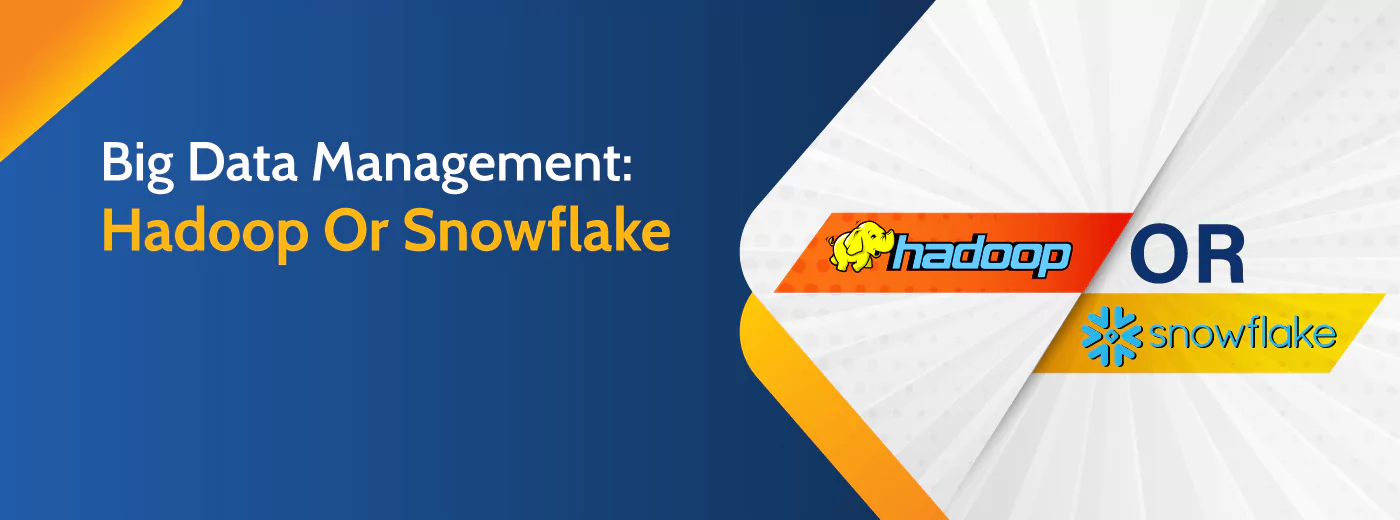In this blog, we will take a deep dive into the differences between two popular big data management systems, Hadoop Distributed File System (HDFS) and Snowflake.
For many decades since the advent of commercial computing and storage resources, the SQL database servers have traditionally held at most gigabytes of information.
However, today, organizations are inundated with imposing information on a regular basis. This phenomenon, often referred to as Data Tsunami, has had a significant impact on the enterprise strategy. The deluge of information has placed the tried and tested IT infrastructure and strategy under tremendous stress.
Over the past decade, the distributed file systems that churn and process data at enterprises have snowballed to contain up to terabytes and even petabytes of data.
Data has emerged to be of critical importance and a crucial competitive advantage for businesses. But in order to capitalize on big data, companies need to invest in strong, robust and reliable big data management infrastructures.
In this blog, we will look at the major developments in big data management and processing architecture at enterprises and how technologies such as MapReduce, Hadoop, Snowflake are helping enterprises to extract value from big data using data sources such as weblogs, sensors, mobile devices, images, audio, social media, clickstream data, text messages, XML documents.
But First Of All, What Is Big Data?
Big Data management is used to describe enterprise data that shows three interrelated trends
- Huge Volume of historical data and streaming, IoT data - 42.6 percent of respondents in a Market Research survey said that they are keeping more than three years of data for analytical purposes
- Massive Variety of data - Not only structured but also semi-structured and unstructured data are growing at enterprises. Studies show that up to 80% of enterprise data is in an unstructured format
- Support for Advanced data analytics workloads - Businesses are increasingly implementing real-time and advanced analytics workloads to support mission-critical business use cases
The growth of big data management needs has been driven by 4 key trends that have come to characterise enterprise data requirements today.
1. New data sources such as mobile phones, streaming and IoT data, medical sensors, social media, photos, videos, etc.
2. Larger quantities of data and metadata that is being captured and analyzed today.
3. New data categories - While previously most data that was captured and analyzed used to be stored in relational databases and contained transactional records, the data today has expanded to include semi-structured and unstructured transactional and sub-transactional data types as well, such as clickstreams, social media text data, photos, videos, audio and XML documents.
4. Commoditized software and hardware - Low-cost software and hardware environments have become popular over recent years and have transformed big data technology, making it cost-effective and feasible to run big data workloads which we will cover below.
Challenges Of Big Data
Information growth: The massive growth in big data - structured, unstructured and semi-structured threaten to swamp traditional IT stack unless organizations are well prepared
Processing power: The traditional approach of using a single, powerful and expensive server for crunching information does not scale for big data. The divide and conquer programming approach using commoditized hardware & software is the way forward
Physical storage: Storing and processing big data can be time consuming and expensive, easily outstripping budgets and timelines
Data issues: Lack of proprietary data formats, data mobility interoperability can make working with big data challenging
Costs: Extract, transform and load operations can be very expensive using traditional architecture and in the absence of specialized software
MapReduce And Hadoop To The Rescue
As we can see, older SQL-based technologies do not simply scale up to meet the challenges posed by big data. This posed a massive challenge to organizations who were trying to work with massive data sets in the early years of the millennia. The search engine giant Google needed to process the massive amount of web-based unstructured information in order to index and rank web pages in their servers for search keywords.
In 2004, Google piloted an innovative technology that used parallel, distributed computing to process and analyze the enormous amounts of web-derived information that it was capturing. The result was a group of technologies and architectural design philosophies that came to be known as MapReduce. Google also created a powerful, distributed file system known as Google File System for holding this enormous information. MapReduce and Google File system subsequently became the foundation for Hadoop and Hadoop Distributed File System (HDFS).
The key concept with the new approach was that of parallel processing - In MapReduce, thousands of cheap commoditized software and hardware were working together on a programming problem.
Soon, it became evident to companies that the MapReduce technology will be not only relevant for Google. A lot of enterprises would benefit from it - if it could be made less complex and cumbersome to manage.
Doug Cutting and Mike Cafarella at Yahoo are credited with developing the Hadoop implementation of MapReduce in 2005 as a standardized, end-to-end and complete solution written in Java and which is suitable for enterprises that want to use MapReduce to derive insights from their big data. After it was created, Hadoop was turned over to the Apache Software Foundation which maintains it as an open-source project with a global community of contributors.
Thanks to the work by Doug Cutting (who is now chief architect at Cloudera) and Mike Cafarella, to work with Big Data, organizations now needed only 3 ingredients - lots and lots of data ( in petabytes scale), lots of servers ( cloud computing came to the rescue here) and Hadoop software.
Apache Hadoop enables enterprises to work with raw data that may be stored in disk files, in relational databases, or both. The data could be both structured and unstructured and is commonly made up of text, binary, or multi-line records.
But The Going Has Not Been So Smooth
Apache Hadoop has been accepted as a working solution for some time now, but it has found difficulties in getting accepted as a working solution for big data solutions at enterprises mainly due to
1. Lack of performance and scalability
2. Lack of flexible resource management
3. Lack of application deployment support
4. Lack of adequate quality of service
5. Lack of multiple data source support
Apache Hadoop tends to be extremely costly and time-taking to deploy, configure and manage; and is especially notorious for offering poor support for low latency queries that many business intelligence users may need. Furthermore, specialized skills are needed for building solutions on Hadoop technology, and this prevents developers from building effective solutions for enterprise needs.
Apache Hadoop throws up challenges to implement, maintain, optimize and scale unless you have strong and deep technology expertise within your company. It is also challenging to integrate Hadoop technology with relational databases. Often, companies need to implement and use 3rd party software such as Cask, Mica, BedRock, hTrunk, Pentaho, Talend etc. to manage Hadoop deployments.
Enter Snowflake
Because of the challenges and high costs associated with deploying, configuring, maintaining and scaling Hadoop based solutions, cloud data management platforms such as Snowflake have become popular among enterprises who wish to implement and take advantage of big data analyses. Snowflake is a cloud data management/ data warehouse platform available in a pay-as-you-go model.
Snowflake stores data on variable length micro partitions but Hadoop deconstructs data files into fixed blocks (typically 128 MB), which is then replicated across multiple nodes. Because of this architecture, Hadoop is a poor solution if the data size is small where the entire dataset can be kept on a single node. Unlike Hadoop technology, Snowflake cloud data management platform can store and process both large and smaller datasets with ease.
Snowflake offers high performance, query optimization, and low latency for big data storage and analysis. Snowflake eliminates the limitations in using your data and with Snowflake, you can combine a data warehouse with a data lake and get a 360-degree view into your customers and operations.
Snowflake provides support for real-time data ingestion and provides immense resilience, flexibility and availability. This eliminates the need to have a team of engineers to manage and maintain a Hadoop based system. Hadoop based systems can only be used and configured by highly technical system admins, database administrators and developers. But Snowflake opens the realms of big data to business analysts, dashboard analysts and data scientists.
Hadoop Distributed File System (HDFS) is also not elastically scalable. The cluster size can only be increased. Unlike HDFS, Snowflake can instantly scale up from small to large scale within milliseconds and then can be quickly scaled back or you can even completely suspend the available resources.
In conclusion, HDFS still does have a future, limited albeit, and is still a popular solution for real-time data capture and processing because of its cost-effective support for text, video and audio data. But the emergence of a plethora of proprietary applications such as Snowflake, Microsoft Blob Storage and Amazon S3 have changed the big data ecosystem significantly in the last 5 years.
Hadoop technology falls short in terms of desired performance, query optimisation, ease of configuration & deployment and low latency for enterprise-scale solutions, and Snowflake stand tall today as the most robust, resilient and reliable data warehouse platform offered today.
To know more about Snowflake and other cloud data management and cloud computing services, get in touch with our representatives for a free consultation session today.



